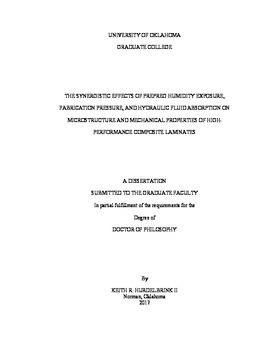| dc.description.abstract | Research and technological enhancements over the past several decades have yielded vast improvements in the area of fabricating high quality composite laminates. Process-induced defects, such as microvoids, however remain a critical concern and are often formed by multiple variables simultaneously. The research presented in this dissertation examines two such processing conditions, the moisture content of prepreg sheets prior to laminate fabrication, and the cure pressure. In particular, the coupled and synergistic effects of these two processing conditions on the laminate microstructure, mechanical properties, and the laminates’ propensity to absorb liquid contaminants are investigated. With regards to the prepreg moisture content, changes in humidity levels of storage conditions or the fabrication environment can alter the overall prepreg moisture content, which in turn affects the formation of microvoids during laminate cure. Additionally, the fabrication pressure also play a critical role in the formation of voids, fiber volume fraction, and mechanical performance of composite laminates. Three high-performance commercial prepregs, including quartz/Bismaleimide, quartz/epoxy, and carbon/epoxy, that are commonly used in aerospace applications were included in this research study.
To alter the moisture content of composite prepregs, prepreg sheets were exposed to four different relative humidity levels of 2%, 40%, 70%, or 99%. The conditioned prepreg sheets were then subsequently used to fabricate eight-ply laminates cured at four different cure pressures of 68.9, 206.8, 344.7, or 482.6 kPa. This procedure resulted in 16 unique laminates for each prepreg system, thus yielding a number of laminates with a wide range of process-induced void fractions at a particular fiber volume fraction. Property functions were illustrated as contour plots and used to analyze the coupled effect of prepreg moisture content and fabrication pressure on the resulting fiber volume fraction, void volume fraction, flexural stiffness, and flexural strength for the three prepreg materials. For all three prepregs, the fiber volume fraction and flexural stiffness was primarily dependent on the fabrication pressure, whereas flexural strength and void volume fraction exhibited more complex and coupled dependency on both the cure pressure and prepreg moisture content. Higher local gradients of the property contour plots at lower fabrication pressures indicated stronger dependency and fluctuations of the laminate properties, such as fiber volume fraction, void volume fraction, and flexure properties due to changes in prepreg moisture content and fabrication pressure.
It is well known that liquid contamination is detrimental to composite laminates as the contamination commonly causes irreversible damage. Water absorption remains the most common type of liquid contamination for composite materials. However, the aerospace-grade composite prepregs are frequently used in structures subjected to a variety of liquid contaminants, including hydraulic fluids. Additionally, changes in the laminate fiber volume fraction and void volume fraction contribute to the composite laminates varying propensity to absorb liquid penetrants. The level of fluid saturation, or equilibrium fluid content, due to variations in the prepreg moisture and fabrication pressure was analyzed for the three commercial aerospace-grade prepregs.
Quartz-reinforced and carbon fiber-reinforced laminate specimens were fully immersed in an aerospace-grade hydraulic fluid for a period of 24 months and 18 months, respectively. Generally, the equilibrium fluid content decreased as relative humidity decreased and fabrication pressure increased. However, each prepreg material had unique absorption behaviors and uptake profiles. Finally, the effect of long-term hydraulic fluid contamination on the flexural stiffness and flexural strength of quartz-reinforced laminates (BMI and epoxy) was discussed. Both matrix materials (i.e., BMI and epoxy) were fairly resilient to long-term hydraulic fluid contamination, in that the flexural properties were reduced by no more than 15% after nearly two years of hydraulic fluid contamination. | en_US |
